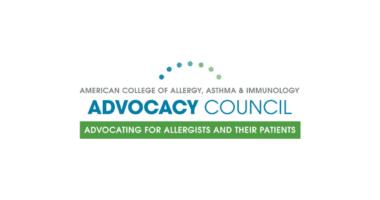Commentary by: J. Allen Meadows, MD, Director of Advocacy & Governmental Affairs and Matt Reiter, Principal, Capitol Associates – This article represents the opinion of the authors.
Many of us were shocked by the news that GlaxoSmithKline (GSK) Pharmaceuticals withdrew Flovent from the U.S. market at the end of 2023. A good number of us are upset and some are asking what can be done. Over the last decade, we have seen the marketing efforts of large pharmaceutical companies shift away from single ingredient inhaled steroids, like Flovent, which are the most appropriate choice for the majority of asthma patients with mild or moderate disease. Instead, we’ve seen an increased focus on the most severe of asthma cases. When was the last time you saw a sample of a single ingredient inhaled steroid?
Broadly speaking, the 10% of asthma patients rated as “most severe” consume as much as half the dollars spent on asthma.1 On the surface, it makes sense to focus on the patients with the most severe symptoms and the highest risk of hospitalization. Keeping these patients out of the ER saves money. But it is also worth asking if this focus on treatments for severe asthma has led to an underinvestment in treatments for people with mild or moderate disease.
Before we examine the root cause of Flovent being withdrawn from the market and the Advocacy Council’s action to change it, let’s state a few important facts to help contextualize this issue.
First, and perhaps most important, generic fluticasone HFA was launched in May 2022 and will continue to be available. Neither its manufacturer, Prasco, nor the Food and Drug Administration (FDA) expects shortages of the generic product.
Despite the availability of the generic, many insurance companies might not cover it. Generic fluticasone HFA is often classified as “nonpreferred” on the formularies of insurance companies. They tend to only cover dry powder inhalers or MDI medicines such as QVAR and Asmanex HFA. Based on the Average Wholesale Price (AWP) and cash prices on GoodRX, these two products are more than twice as expensive as generic fluticasone. In late December 2023, fluticasone HFA had a cash price on GoodRx as low as $78.70 in Birmingham, Alabama.
Insurance coverage issues are not unique to fluticasone. This is a frequent problem with many classes of drugs. Even if a patient is lucky enough to have a plan that covers nonpreferred drugs, they are often charged excessive copayments. Almost all pharmaceutical companies are still giving huge rebates on the more expensive inhaler products.
One strategy that has been suggested, and frequently attempted, is to petition the insurance companies to cover a needed drug, like fluticasone HFA. This leads to a never-ending battle that patients and health care professionals almost always lose. It is the equivalent of endlessly playing “Whack a Mole.” Wouldn’t it be better to “unplug” the Whack a Mole machine? Let’s examine how that might/could happen.
What too many of us are missing is the hidden third party that stands between the doctor and the patient in almost every exam room – the Pharmacy Benefit Manager (PBM). PBMs were intended to facilitate the delivery and manage the cost of drugs between manufacturers and health plans. When PBMs first entered the market, they played a vital role in providing small regional insurance companies with added leverage to negotiate with big pharma. However, consolidation in both the PBM market and the health insurance market has elevated PBMs to one of the most influential pieces of the drug supply chain. PBMs develop lists – or formularies – of the drugs covered by a health insurer and negotiate rebates that primarily go to the PBM, not to lower prices for the consumer or the insurance company.

Pharmacy Benefit Managers (PBMs)
- One of the most influential parts of the drug supply chain.
- The hidden third party that stands between the doctor and the patient in almost every exam room.
- A drug becomes preferred not necessarily because it is better or cheaper, but because it offers the PBM a higher rebate.
- PBMs are also behind the endless barrage of prior authorizations and other pain points that ultimately prevent patients from accessing the medications we prescribe them.
Three PBMs control upwards of 89% of the market. In 2023, just 10 insurance companies have two-thirds of the private insurance market: the percentage is even higher when you add in the BC/BS association. Further complicating things, we are seeing more horizontal consolidations between insurance companies and PBMs. Fewer companies seem to be controlling a larger portion of health care.
PBMs are paid rebates from the pharmaceutical company in exchange for including their new drugs and products in the PBMs formularies. A drug becomes preferred not necessarily because it is better or cheaper, but because it offers the PBM a higher rebate. Each new drug in a coverage class must cost more than its predecessor to become preferred, causing a vicious cycle of higher prices. The rebate system might be justified if the rebates found their way to the patients, but that is rarely the case. This insanity continues when expensive branded drugs are preferred over cheaper generics.
PBMs have become so powerful that they demand higher and higher rebates, which has the potential to make the drug no longer commercially viable for the pharmaceutical company. There is concern that PBM’s could leverage these rebates to the point where it may no longer be profitable for the pharmaceutical company to continue marketing the product, such that they just discontinue production of the product. Rather than a product being pulled because of efficacy or safety issues, it is discontinued due to PBMs pushing too hard for their rebates (which rarely get passed on to the consumer).
PBMs are also behind the endless barrage of prior authorizations, step therapy, nonmedical switching games, and other pain points that ultimately prevent patients from accessing the medications we prescribe to them. PBMs want to pick the medication(s) your patients receive based on what is best for their customers and shareholders. The endless requests for medical records to justify giving allergy shots may be the latest “brainchild” of the PBM industry.
Some estimate that branded drug prices would drop by a third if PBM rebates were eliminated. If you need more convincing, consider this: the biggest pharmaceutical company in the world brings in less than $80 billion a year. The three biggest PBMs have an 80% market share, and each brings in more than $100 billion a year. All the while, the PBMs manufacture no products and employ far fewer people than the pharmaceutical companies. How is it that the middleman is more profitable than the manufacturer?
Until recently, few policymakers in Washington were aware of the gravity of the PBM issue. Your Advocacy Council has tirelessly made educating Washington policymakers on PBMs our top priority. In partnership with many organizations, including the American Medical Association, we made progress in 2023. Over the last 10 months, we have seen more action in Congress about regulating PBMs than in the previous 10 years combined.
Congress is considering a variety of bipartisan bills that would address PBMs. Common policy options in these bills range from more transparency for rebates and formulary decisions to prohibiting rebates altogether.
Given the amount of bipartisan support for these measures within each Congressional Committee with jurisdiction over PBMs, we are optimistic Congress will act in 2024 to rein in this tyranny. However, the PBMs have a powerful lobbying force. When these bills come up for a vote, we will need you to contact your members of Congress to demand change.
How are allergists supposed to effectively manage our patients’ chronic conditions and achieve the laudable goals of reducing cost and improving care quality if the PBMs won’t allow patients to access the medications we know are right for them? We are counting on you to help make a difference for our patients by contacting Congress. Look for Advocacy Council emails or articles in Insider to be aware of when it’s time to contact members of Congress.
The Advocacy Council: ADVOCATING FOR ALLERGISTS AND THEIR PATIENTS.



